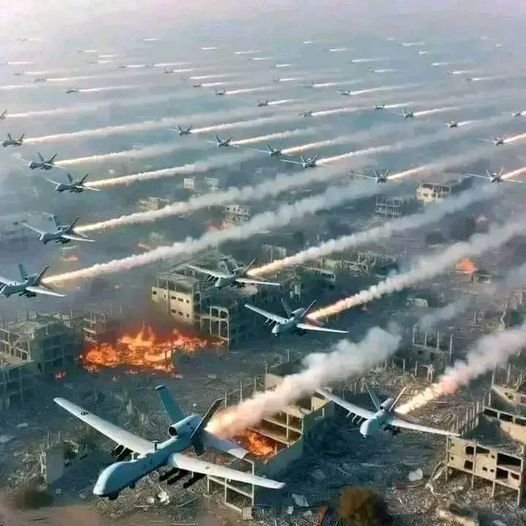A Region on the Brink
Tensions between Israel and Iran have escalated to unprecedented levels as retaliatory military strikes between the two nations continue to unfold in one of the most dangerous confrontations the Middle East has seen in decades. The conflict, once limited to proxy wars and covert operations, has now erupted into direct, large-scale warfare, with significant civilian and military casualties on both sides. Global leaders are urgently calling for restraint as the situation threatens to spiral into a full-blown regional war.
The Spark of a Larger Fire
The current round of hostilities began following a series of covert operations and missile attacks over the past several weeks. Tensions had been steadily rising due to Iran’s growing influence across the region and Israel’s intensified intelligence and security operations targeting Iranian-linked groups in Syria, Lebanon, and the West Bank. What began as tit-for-tat airstrikes and cyberattacks has now transformed into open military confrontation between the two regional powers.
On June 12, Israel launched a coordinated wave of airstrikes on targets deep inside Iran. These included key missile development sites, nuclear research facilities, and strategic military installations. Iranian authorities reported multiple explosions in Tehran, Isfahan, and near the port city of Bandar Abbas. The attacks were described as the most aggressive Israeli operation against Iran to date, triggering immediate retaliation.
Iran’s Massive Response
In response to the Israeli offensive, Iran retaliated with a barrage of missiles and drones, targeting Israeli military bases, air defense batteries, and civilian infrastructure. Waves of long-range projectiles rained down on Tel Aviv, Haifa, Ashkelon, and several military installations across southern and northern Israel. While Israel’s Iron Dome and David’s Sling defense systems intercepted many incoming threats, several missiles reached their targets, causing significant destruction and civilian loss of life.
Iran’s missile command claimed responsibility for the operation, stating that the strikes were a legitimate response to “Israeli aggression and illegal incursion into sovereign Iranian airspace.” Iranian leadership warned that any further Israeli strikes would result in broader retaliation, including attacks on U.S. and allied bases in the Gulf region.
Israeli Countermeasures and Ongoing Operations
Following the Iranian missile strikes, Israel initiated a second phase of its military response, this time utilizing long-range bombers and advanced stealth drones. The Israel Defense Forces (IDF) targeted critical Iranian infrastructure, including radar sites, underground bunkers, and Revolutionary Guard installations. Israel also confirmed that cyber units had successfully penetrated Iranian air defense systems, temporarily disabling radar coverage in key zones.
The Israeli government has remained steadfast in its stance. Prime Minister Benjamin Netanyahu addressed the nation, stating, “We will not tolerate existential threats against our people. Israel has the right to defend itself—firmly, decisively, and with all the tools at our disposal.”
Civilian Toll Mounts on Both Sides
The growing intensity of the military exchanges has exacted a heavy price on civilians. In Israel, sirens continue to wail as cities face near-daily bombardments. Families are spending long hours in bomb shelters. Public infrastructure such as schools, hospitals, and power stations have been hit, leaving thousands without access to essential services. The civilian death toll is rising, with dozens confirmed dead and hundreds more wounded.
Iran is facing equally dire consequences. Explosions have rocked major cities, and panic has spread across urban centers. Hospitals in Tehran and Isfahan are reportedly overwhelmed with casualties. Rescue workers are still pulling bodies from the rubble of collapsed buildings. Fuel shortages, electricity outages, and disruptions in communication are adding to the chaos as citizens attempt to flee potential future targets.
Military Losses and Strategic Objectives
The military toll is equally staggering. Dozens of Israeli aircraft have been deployed in combat missions across Iranian airspace, with at least two jets reportedly downed by Iranian air defenses. Iranian missile launchers, drone factories, and command centers have been severely damaged or destroyed in Israeli raids. Satellite imagery has confirmed widespread destruction in several Iranian military bases, prompting concerns about the potential use of longer-range ballistic missiles in the next phase of the conflict.
Iran’s Revolutionary Guard has suffered losses of senior commanders, and several military facilities critical to Iran’s missile program have been rendered inoperable. On the Israeli side, strategic airfields and intelligence stations have faced direct hits, prompting emergency evacuations and relocation of key assets.
Diplomatic Fallout and Global Alarm
The international community has reacted with alarm. Global powers including the United States, Russia, China, and the European Union have issued statements urging immediate de-escalation. Emergency meetings have been held at the United Nations Security Council, with special envoys dispatched to the region in an effort to broker a ceasefire.
The United States, traditionally a close ally of Israel, has walked a diplomatic tightrope. While reiterating support for Israel’s right to self-defense, American officials have also called for a cooling of tensions. U.S. naval forces in the Persian Gulf have been placed on high alert, and missile defense systems have been deployed at military bases in Iraq, Bahrain, and Qatar.
Meanwhile, Gulf nations are preparing for the possibility of regional spillover. Saudi Arabia, the UAE, and Kuwait have stepped up security measures and called on both Tehran and Tel Aviv to show restraint. There is growing concern that Hezbollah in Lebanon or pro-Iranian militias in Iraq and Syria may become more directly involved, opening new fronts in the conflict.
Economic Repercussions
The conflict has rattled global markets. Oil prices have surged amid fears of supply disruption through the Strait of Hormuz, a critical chokepoint for global energy transport. Stock markets across Asia and Europe dipped sharply as investors reacted to the escalating crisis. Major airlines have suspended flights over the region, and maritime insurance premiums have spiked for vessels operating in the Persian Gulf.
Within Israel and Iran, both economies are facing tremendous pressure. Business closures, interrupted supply chains, and disrupted daily life have contributed to mounting economic losses. In Tehran, the Iranian rial has plummeted, and ATMs are running dry. In Israel, tourism has come to a standstill, and the tech sector—once a symbol of economic resilience—is now grappling with outages and security breaches.
Humanitarian Crisis Brewing
Humanitarian organizations are warning of an impending crisis as the conflict grinds on. Medical supplies are running low in hospitals, particularly in Iran, where sanctions have already limited access to advanced medicines. Power and water disruptions are increasing in cities hit by Israeli airstrikes. Refugee flows from northern Iran into bordering countries like Turkey and Iraq are beginning to mount.
The Red Cross and other NGOs have called for humanitarian corridors and temporary ceasefires to allow for evacuation of civilians and distribution of aid. However, ongoing hostilities and mutual distrust between the two governments are hampering relief efforts.
The Shadow of Nuclear Escalation
Perhaps the most alarming dimension of this conflict is the specter of nuclear escalation. While both nations have conventional military capabilities, Iran’s nuclear program and Israel’s alleged nuclear arsenal remain highly sensitive issues. Though there is no current evidence that nuclear weapons are being considered, analysts fear that the collapse of diplomacy could open the door to future nuclear brinkmanship.
Iran has hinted at withdrawing entirely from nuclear agreements and resuming enrichment at full capacity. Israel, in turn, has stated it will not allow Iran to develop a nuclear weapon, by any means necessary. The mere suggestion of a nuclear standoff has spurred global efforts to resurrect dialogue and prevent further escalation.
What Comes Next?
As the world watches with bated breath, the question remains: how far will this go? The conflict, while rooted in years of animosity, has now reached a turning point. Both nations have shown resolve and military capability, but neither appears ready to back down.
Efforts to mediate have so far failed to produce a ceasefire. However, regional actors such as Turkey and Qatar are attempting to serve as intermediaries. Pope Francis, along with leaders from the Arab League and African Union, has called for an emergency peace summit.
In the streets of Tel Aviv and Tehran, citizens protest the war, mourn the dead, and pray for peace. Social media is flooded with personal stories of loss, heroism, and hope. Despite the political rhetoric, ordinary people on both sides are united in their desire to see the violence end.
Conclusion
The intensifying retaliatory strikes between Israel and Iran have not only deepened a long-standing conflict but have also brought the region closer to a broader, more dangerous confrontation. With mounting casualties, growing economic tolls, and rising fears of nuclear escalation, the world is now at a critical crossroads.
Whether this crisis becomes a brief but painful chapter in Middle Eastern history or the beginning of a prolonged war will depend on the decisions made in the coming days. The path to peace is narrow, but still possible—if cooler heads prevail and diplomacy is given another chance.


